|
This
picture gallery summarizes the biota found under beachrock slabs at Playa
Estacion, Puerto Penasco, Sonora, Mexico.
It
should be used to complete lab activity 9.2.
|
Tethya
aurantia
|
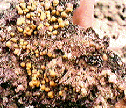 |
"Golf
ball sponge"
| Phylum |
Porifera |
| Class |
Demospongiae |
| Order |
Hadromerida |
| Family |
Tethyidae |
|
| Morphology |
Golf-ball
shaped, yellow-orange, warty sponge. It has root-like processes
at its base that attach it to rock surfaces. Inside it has tough
fibers that radiate out from the center. One to three inches
in diameter. |
| Feeding |
Filter feeding |
| Defense |
Unpalatable |
| Reproduction |
Asexual budding
and sexual larval production |
| Habitat |
On the undersides
of rocks, rocky overhangs, caves and crevices in the lower intertidal
and shallow subtidal |
| Distribution |
Throughout the
world's oceans including the Gulf of California |
| Other |
Contain a layer
of symbiotic algae just below their surface |
|
|
Geodia
mesotriaena
|
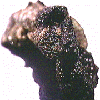 |
"Fuzzy
gray sponge"
| Phylum |
Porifera |
| Class |
Demospongiae |
| Order |
Choristida |
| Family |
Geodiidae |
|
| Morphology |
Its
color varies from white, gray, brown to purple on the outside
and white or pale cream inside. The sponge spreads laterally
into a massive cake, often forming very large colonies. Topped
by leathery with many excurrent openings (oscula).
A distinctive
feature of this sponge is that the large pores(oscula) are restricted
to sieve plates, which are leathery discs about 2-3 sm in diameter,
with many openings. Its internal chambers shelter many other
creatures including small porcelain crabs, brittle stars, and
segmented worms. |
| Feeding |
Filter feeding |
| Defense |
Unpalatable |
| Reproduction |
Asexual budding
and sexual spawning |
| Habitat |
Lives in the
lowest tidal area under boulders. |
| Distribution |
From southern
Alaska to the Gulf of California. |
| Other |
Predators are
few including some nudibranchs and brittle stars. Its internal
chambers shelter many other creatures including small porcelain
crabs, brittle stars, and segmented worms. |
|
|
Petrolisthes
gracilis
|
 |
"Slender
rock slider"
| Phylum |
Arthropoda |
| Class |
Crustacea |
| Order |
Decapoda |
| Family |
Porcellanidae |
|
| Morphology |
Small,
very flat, bluish-green crab with white spots. Small, fifth
pair of legs folded over the back edge of the body. The legs
and body are relatively hairless. |
| Feeding |
Filter particles
from water using the hair on their mouth parts |
| Defense |
Hard exoskeleton
and ability to cling to the undersides of stones in very cramped
quarters |
| Reproduction |
Separate sexes.
Females brood eggs under their abdominal flaps until they hatch. |
| Habitat |
Found under
stones. |
| Distribution |
From the upper
Gulf of California and Bahia Magdalena to as far south as Bahia
Tongola-Tangola, Mexico. |
| Other |
|
|
|
Petrolitshes
hirtipes
|
 |
"Fringed
rock slider"
| Phylum |
Arthropoda |
| Class |
Crustacea |
| Order |
Decapoda |
| Family |
Porcellanidae |
|
| Morphology |
Small,
very flat, brown crab with small, fifth pair of legs folded
over the back edge of the body. The legs all bear a long fringe
of hair. |
| Feeding |
Filter particles
from water using the hair on their legs and mouth parts |
| Defense |
Hard exoskeleton
and ability to cling to the undersides of stones in very cramped
quarters |
| Reproduction |
Separate sexes.
Females brood eggs under their abdominal flaps until they hatch. |
| Habitat |
Common under
stones and in crevices of reefs, coral and sponges in the lower
intertidal. |
| Distribution |
Lower Pacific
Baja and throughout the Gulf of California. |
| Other |
|
|
|
Pilumnus
townsendi
|
 |
"Townsend's
hairy crab"
| Phylum |
Arthropoda |
| Class |
Crustacea |
| Order |
Decapoda |
| Family |
Xanthidae |
|
| Morphology |
Identified
by four spines on the front outside edges of the body and spiny,
hairy claws. Two different types of hairs on the purple body:
one is long and stiff and the other is short and soft. |
| Feeding |
Scavengers who
feed on floating food particles. |
| Defense |
Claws and hard
exoskeleton and able to hide in small cavities |
| Reproduction |
Separate sexes.
Females brood eggs on pleopods until they hatch. |
| Habitat |
Live under rocks
and boulders; some prefer drainage channels in rocky areas where
they have access to constant water. |
| Distribution |
Upper gulf to
Bahia Manzanillo. |
| Other |
One of many
hairy crabs living in the Gulf of California intertidal. Docile
to handle, rarely large enough to pinch. |
|
|
Alpheus
californiensis
|
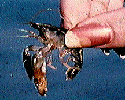 |
"Snapping
shrimp"
| Phylum |
Arthropoda |
| Class |
Crustacea |
| Order |
Decapoda |
| Family |
Alpheidae |
|
| Morphology |
Colorful,
fast, backwards swimming shrimp that are easily identified by
their one large claw that is modified for making loud clicking
or popping noises. |
| Feeding |
Snap large claw
to stun prey. Use claw to grab small animals or morsels of food
floating by. |
| Defense |
Hard shell on
body (after molting, the body is soft. The shell hardens after
a few hours, however, during that time they are vulnerable). |
| Reproduction |
Separate sexes.
Females brood eggs on pleopods until they hatch. |
| Habitat |
Lives in tunnels
under rocks in a sandy substrate. |
| Distribution |
Southern California
to the Gulf of California, common at Puerto Penasco |
| Other |
If large claw
is pulled off the other hand will develop a large claw. |
|
|
Barbatia
reeveana
|
 |
"Reeve's
ark shell"
| Phylum |
Mollusca |
| Class |
Pelecypoda |
| Order |
Arcoida |
| Family |
Arcidae |
|
| Morphology |
Large,
white, ribbed shell with dark brown, fuzzy periostracum. Shape
often distorted from growing between rocks. |
| Feeding |
Filter feeder |
| Defense |
Shell and ability
to live in tight spaces |
| Reproduction |
Separate sexes
and spawning |
| Habitat |
Under rocks
in sandy or muddy areas of tidal flats and subtidally in lagoons |
| Distribution |
Lower Pacific
Baja, throughout the Gulf of California, south to Peru |
| Other |
|
|
|
Nerita
funiculata
|
 |
"Small
nerite"
| Phylum |
Mollusca |
| Class |
Gastropoda |
| Order |
Archeogastropoda |
| Family |
Neritidae |
|
| Morphology |
Globular
shell, black to gray, with spiral ribs. Inner lip of aperture
with small nodules. Tight fitting operculum forms water tight
seal. Commonly 0.75 inches in diameter. |
| Feeding |
Scrapes algae
from rocks. |
| Defense |
Active on tops
of rocks at low tide |
| Reproduction |
|
| Habitat |
On rocks at
high tide levels. |
| Distribution |
Outer coast
of Baja California, through the Gulf to Peru. |
| Other |
Gregarious found
in clumps of up to several hundred individuals. |
|
|
Nerita
scabricosta
|
 |
"Rough-ribbed
nerite"
| Phylum |
Mollusca |
| Class |
Gastropoda |
| Order |
Archaeogastropoda |
| Family |
Neritidae |
|
| Morphology |
Globular
shell, black to gray, with spiral ribs. Inner lip of aperture
with 4 large teeth. Tight fitting operculum forms water tight
seal. Commonly 1.5 inches in diameter |
| Feeding |
Scrapes algae
from rocks. |
| Defense |
Live high in
the intertidal |
| Reproduction |
|
| Habitat |
On rocks at
high tide levels. |
| Distribution |
Outer coast
of Baja California, through the Gulf to Equador. |
| Other |
Snail increases
in size as one moves south in the Gulf. |
|
|
Turbo
fluctuosus
|
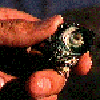 |
"Turban
shell"
| Phylum |
Mollusca |
| Class |
Gastropoda |
| Order |
Archeogastropoda |
| Family |
Turbinidae |
|
| Morphology |
Top-shaped
shell with a heavy calcarous operculum. Color is variable, from
bright orange to dark green. Commonly 2.5 inches. |
| Feeding |
Grazes on algae. |
| Defense |
Closes its shell
aperature with a hard, calcareous operculum |
| Reproduction |
|
| Habitat |
Abundant on
rocky shores. |
| Distribution |
Throughout the
Gulf of California and south to Peru and Ecuador |
| Other |
Operculum is
collected for jewelry. Best observed at night. |
|
|
Diadora
inaequalis
|
 |
"Orange
keyhole limpet"
| Phylum |
Mollusca |
| Class |
Gastropoda |
| Order |
Archaeogastropoda |
| Family |
Fissurellidae |
|
| Morphology |
Opening
at top of cap-shaped shell; fleshy orange mantle; broad in middle
and constricted at both ends. |
| Feeding |
Graze on microscopic
algae on rocks. |
| Defense |
Clamp tightly
to rocks and are protected by shell |
| Reproduction |
|
| Habitat |
Found on the
underside of rocks in the intertidal. |
| Distribution |
Throughout the
Gulf of California, south to Galapagos Islands. |
| Other |
|
|
|
Selenkothuria
lubrica
|
 |
"Sulfur
cucumber"
| Phylum |
Echinodermata |
| Class |
Holothuroidea |
| Order |
Aspidochirota |
| Family |
Holothruiidae |
|
| Morphology |
Maximum
length of 15 cm, usually a sulfur-yellow color (tips of their
feet), the base color ranges from gray-brown to purplish-black. |
| Feeding |
Plankton eaters. |
| Defense |
Will eject part
of its stomach lining as a decoy when disturbed. |
| Reproduction |
Separate sexes
and spawning |
| Habitat |
Under rocks
in the lower mid intertidal zone in a cluster. |
| Distribution |
Ranges from
upper Gulf of California to Ecuador and the Galapagos Islands. |
| Other |
|
|
|
Echinometra
vanbrunti
|
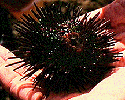 |
"Purple
sea urchin"
| Phylum |
Echinodermata |
| Class |
Echinoidea |
| Order |
Camarodonta |
| Family |
Echinometridae |
|
| Morphology |
A
dark purple urchin with long (one inch) slender spines. |
| Feeding |
Graze on algae |
| Defense |
The brittle
spines may break off and cause puncture wounds that are very
painful. |
| Reproduction |
Separate sexes
and synchronous spawning |
| Habitat |
Intertidally
on rocky substrate.Particularly in crevices and cavities in
rocks and reefs, where it can avoid the full impact of the surf. |
| Distribution |
Northern Gulf
of California to Peru and Galapagos Islands. |
| Other |
|
|
|
Aplidium
sp.
|
 |
"Sea
pork"
| Phylum |
Chordata |
| Class |
Ascidiacea |
| Order |
Enterogona |
| Family |
Polyclinidae |
|
| Morphology |
Large,
fleshy colonies made up of subunits. Each subunit contains many
individuals arranged radially around an excurrent pore and covered
by a gelatinous tunic. The colony is smooth and firm to the
touch and from pale to vivid orange in color. |
| Feeding |
Filter feeder.
Each individual produces a ventilating current using a ciliated,
sticky basket-like paharynx to strain particles from the water. |
| Defense |
Produces distasteful,
poisonous chemicals |
| Reproduction |
Sexually produced
tadpole larvae have all the characteristics of chordates and
are somewhat fish-like. These settle and transform into sessile
adults which bud to produce a colony. |
| Habitat |
Under rocks
in the intertidal and on rock surfaces in the subtidal. |
| Distribution |
|
| Other |
|
|
|













